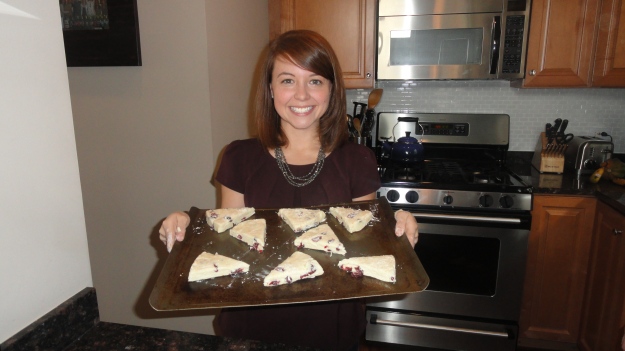I fell in love with the flaky pastry that hails from Scotland while living in New York City. I would walk to this cute corner coffee shop owned by a Brit couple and order a scone and latte to enjoy while I journaled about my summer in the big city. While I’ve been a connoisseur of scones for quite some time, I’ve never attempted to make my own. So I added scone-making to my goals on my Thirty-One List.
While visiting my best friend in Chicago last week, she decided to help me accomplish one of my 31 tasks. Having a culinary degree from Argentina, I agreed that she would be the best person to guide me through the process. We used the Cook’s Illustrated recipe and my BF indicated it is the Bible of all things food. The recipe was precise but actually pretty simple and the scones turned out buttery and delicious…definitely a culinary splurge.
Orange Cranberry Scones Recipe
2 cups all-purpose flour
1 Tablespoon baking powder
3 Tablespoons sugar
1/2 teaspoon salt
5 Tablespoons butter, chilled and cut into small cubes (cut these quickly so they don’t melt in your hands)
1 to 1 1/2 teaspoons grated orange zest
3/4 cup dried cranberries
1 cup heavy cream
1. Adjust oven rack to middle position and heat oven to 425 degrees.
2. Place the flour, baking powder, sugar, and salt in the bowl of a food processor fitted with a steel blade. Pulse 6 times to combine. (I counted 1 one-thousand for each pulse.)
3. Distribute the butter evenly over the dry ingredients, sprinkle the zest in, and then combine with a dozen 1-second pulses. Add the cranberries and pulse one more time. Transfer to medium size bowl.
4. Stir in heavy cream with rubber spatula or fork until dough begins to form, about 30 seconds.
5. Transfer dough and all dry, floury bits to countertop and knead dough by hand just until it comes together into a rough, slightly sticky ball, 5 to 10 seconds. Pat the dough into an 8-inch circle (we used a cake pan) and cut into 8 wedges. Put the wedges on the prepared baking sheet.
6. Bake until scone tops are light brown, 12 to 15 minutes. Cool on wire rack for at least 10 minutes. Serve warm or at room temperature.






















